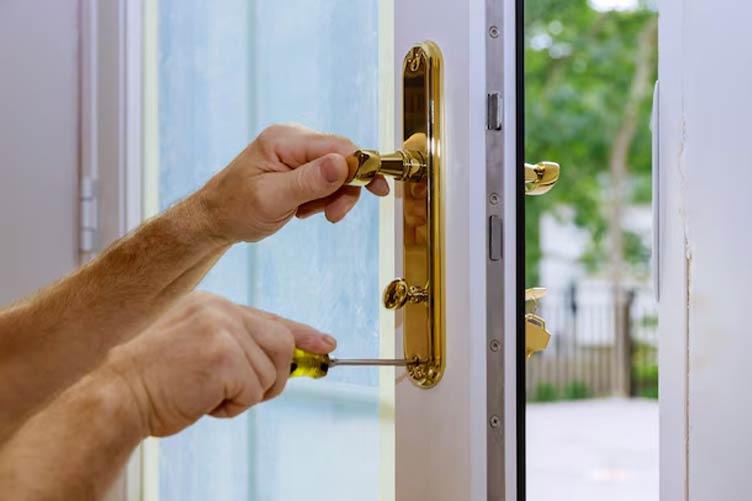When it comes to home security, your choice of a deadbolt lock can make all the difference. A high-quality deadbolt adds an extra layer of protection against break-ins, giving you peace of mind that your home and loved ones are safe. But with so many options available, how do you know which one is best for your needs?
At Hogans Locksmith, we’ve helped homeowners across Roscrea, Nenagh, Birr, and Thurles secure their properties for over 30 years. In this guide, we’ll walk you through the key factors to consider when choosing a deadbolt lock.
1. Understand the Different Types of Deadbolts
Not all deadbolts are the same, and choosing the right type is the first step to enhancing security.
Single-Cylinder Deadbolt
This is the most common type of deadbolt, featuring a keyhole on the outside and a thumb-turn on the inside. It’s convenient for quick locking and unlocking from inside, but it can be vulnerable if there’s a window near the door—an intruder could break the glass and turn the thumb latch.
Double-Cylinder Deadbolt
This type requires a key to lock and unlock from both sides, offering added security. It’s ideal for doors with glass panels, as burglars can’t simply break the glass and reach in. However, it can pose a safety risk in emergencies, as you’ll need a key to exit the house.
Keyless Electronic Deadbolt
For a modern approach, keyless deadbolts offer PIN code access instead of a traditional key. Some models also integrate with smart home systems, allowing remote control via a smartphone app. These are great for convenience and eliminating the risk of lost keys, but they do require battery power to operate.
Vertical (Jimmy-Proof) Deadbolt
This type of deadbolt is often found on apartment doors. It sits on the inside of the door and interlocks with the frame, making it highly resistant to forced entry.
2. Consider the Lock’s Material and Durability
A deadbolt’s strength depends on the materials used in its construction. Look for solid hardened steel, brass, or bronze components, as these are highly resistant to tampering and forced entry.
Avoid deadbolts with plastic internal parts, as they are more prone to wear and can easily break under pressure. A well-constructed deadbolt should have a steel strike plate and a one-inch bolt throw to prevent burglars from easily kicking in the door.
3. Ensure Proper Installation for Maximum Security
Even the strongest deadbolt won’t provide the security you need if it’s not installed correctly. Proper installation involves:
- A reinforced strike plate: The strike plate is where the deadbolt extends into the door frame. Reinforced plates with long screws (at least 3 inches) ensure the lock is securely anchored into the frame, preventing forced entry.
- Alignment with the door frame: A poorly aligned deadbolt won’t latch securely, making it easier to break. Make sure the bolt fully extends into the strike plate when locked.
- Professional installation: If you’re unsure about installing a deadbolt properly, hiring a locksmith ensures it’s done right and eliminates vulnerabilities.
4. Think About Convenience and Accessibility
While security is the top priority, you should also consider ease of use. If multiple family members or employees need access, a keyless entry deadbolt might be the best option. Many modern deadbolts also allow you to create temporary PIN codes, which is useful for guests, cleaners, or contractors.
Additionally, if you frequently misplace keys, a smart deadbolt with remote access could be a game-changer. These locks allow you to lock and unlock your door from your smartphone, providing added convenience.
5. Choose a Weather-Resistant Deadbolt for Exterior Doors
If you’re installing a deadbolt on an exterior door exposed to the elements, ensure it is weather-resistant. Look for:
- Anti-corrosion finishes: Stainless steel, brass, and nickel-plated finishes are best for resisting rust and wear.
- Sealed keyholes: To prevent dirt, moisture, and debris from affecting the lock’s mechanism.
- Cold-weather durability: If you live in an area with harsh winters, choose a lock designed to operate smoothly in freezing conditions.
6. Beware of Common Deadbolt Weaknesses
Even high-quality deadbolts have vulnerabilities if not used correctly. Be mindful of these common security risks:
- Short screws in strike plates: Always use 3-inch screws instead of the standard shorter ones to secure the strike plate into the wall frame.
- Thin or weak doors: A strong deadbolt won’t matter if the door itself is easy to break through. Use solid wood or metal-core doors for better security.
- Lost keys or compromised PIN codes: If you lose your key or share a PIN code with too many people, change the lock or update your code to maintain security.
7. Consult a Professional Locksmith for the Best Choice
Choosing the right deadbolt lock is a crucial step in home security, but with so many options available, it can be overwhelming. A professional locksmith can assess your needs, recommend the best lock for your property, and ensure proper installation for maximum protection.
At Hogans Locksmith, we offer expert advice and top-quality deadbolt installations across Roscrea, Nenagh, Birr, Thurles, and surrounding areas. Whether you need a high-security deadbolt, keyless entry system, or lock replacement, our experienced team is here to help.
Final Thoughts
Investing in a quality deadbolt is one of the simplest yet most effective ways to secure your home or business. By choosing a durable, high-rated lock and ensuring proper installation, you can significantly reduce the risk of break-ins.
If you need help selecting or installing a deadbolt, contact Hogans Locksmith today. With over 30 years of experience, we provide trusted, professional locksmith services to keep your property safe and secure.
Call us today for expert locksmith services in your area!

